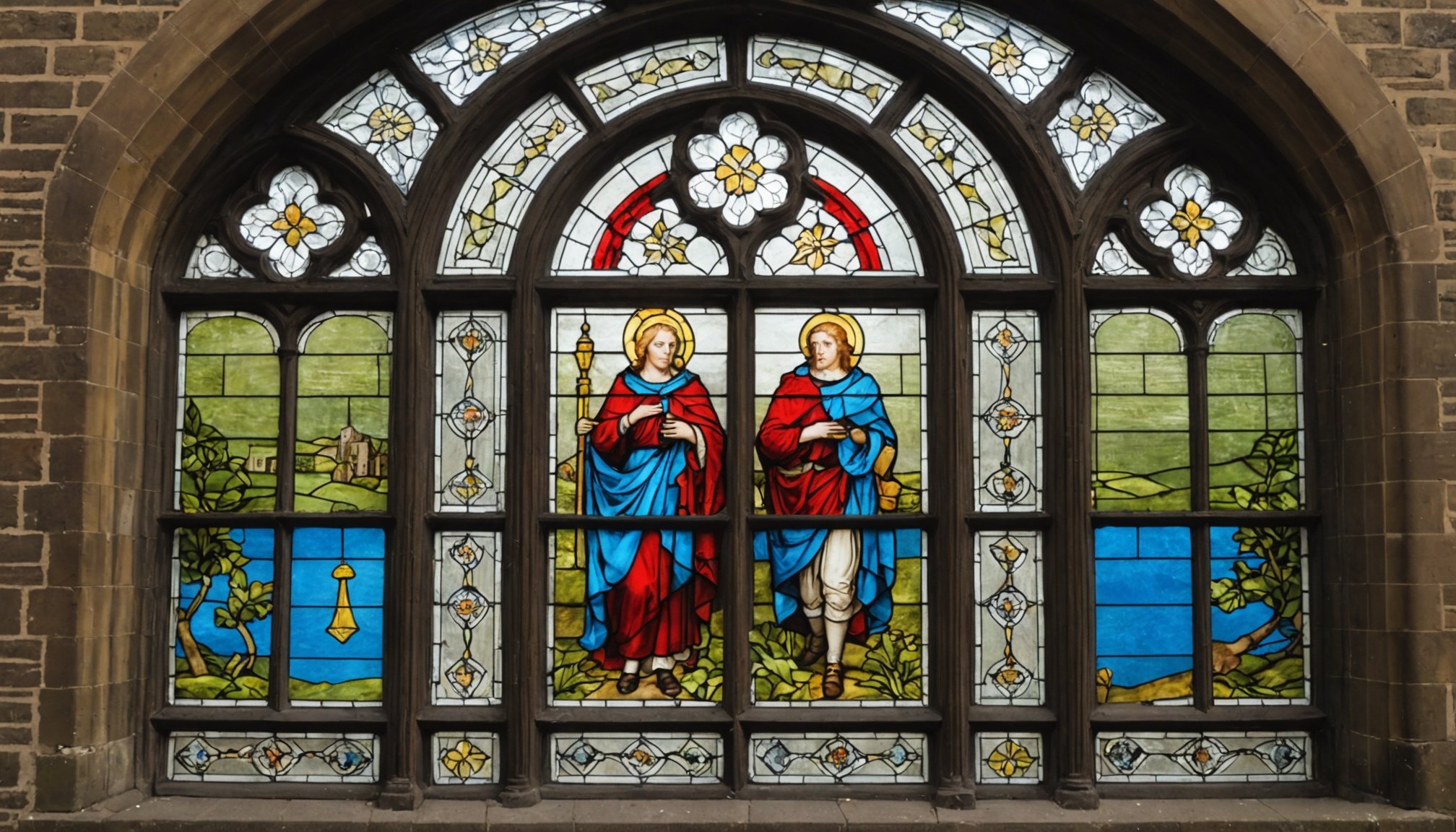Understanding Stained Glass Window Restoration
Stained glass windows hold cultural significance in UK heritage homes, offering a vibrant glimpse into historical and spiritual narratives. Their intricate artwork reflects architectural grandeur across centuries, becoming vital components of heritage preservation. The importance of stained glass restoration cannot be overstated, as it ensures these masterpieces endure for future generations. Restoration techniques breathe new life into the fading splendour, maintaining their historical vibrancy and structural integrity.
As with any ageing masterpiece, stained glass windows encounter several challenges. Common problems include fading colours due to exposure to sunlight and environmental pollutants, which degrade the delicate materials over time. Structural issues, such as cracks or breaks in the glass or deteriorating leadwork, can threaten the overall stability of the artwork. Furthermore, inappropriate previous restorations can result in significant damage, complicating restoration efforts.
This might interest you : Discover the Best Color Schemes for a Warm and Inviting Cottage Living Room in the UK
Mastering the art of stained glass restoration involves a meticulous approach. Each window demands individual assessment to tailor restoration techniques effectively. These methods often include cleaning procedures, leadwork repairs, and glass replacement or enamel touch-ups, all of which are vital in preserving the window’s original character and function. Embracing these techniques allows for a preservation of this essential aspect of our architectural heritage.
Tools and Materials for Restoration
When tackling stained glass restoration, having the right tools is crucial. Essential restoration tools include cutting tools like glass cutters and pliers, vital for resizing and shaping glass pieces. Adhesives, such as special bonding agents, ensure that pieces are securely attached without compromising aesthetics. Protective gear, including gloves and goggles, is necessary to prevent injuries while handling sharp materials.
Also to read : Top Strategies for Year-Round Insulation of Your UK Conservatory: Enhance Comfort and Efficiency
Alongside tools, maintenance supplies play a significant role in keeping the stained glass in pristine condition. Cleaning agents help remove dirt and grime that build up over time, maintaining the clarity of the glass. Additionally, protective coatings can be applied to safeguard against environmental damage.
For glass replacement, it is imperative to source materials that match the original design. This involves selecting glass types and colours that mirror the original palette. Working with suppliers who provide historically accurate glass ensures that any replacement work is as seamless and authentic as possible.
Restoration requires a balance of skills and resources. By equipping yourself with the right tools and glass replacement materials, you can approach each project with confidence, knowing you have everything needed to maintain the integrity and beauty of stained glass artworks.
Step-by-Step Restoration Techniques
Restoration techniques for stained glass require precision and care to ensure the windows’ longevity and aesthetic appeal. These methods focus on maintaining the artwork’s original integrity while introducing necessary repairs and improvements.
Initial Assessment and Planning
The initial step in any restoration process involves a comprehensive inspection. Conducting a thorough inspection of the stained glass windows allows restorers to identify issues such as cracks, corrosion, or misalignment. Following this, documenting existing conditions is crucial, as it forms the basis of a detailed restoration plan. A restoration plan outlines all necessary repair methods and preservation strategies. When complex issues arise, engaging specialists is often advised. Specialists bring expert knowledge in preservation strategies, ensuring that each element of the stained glass is treated with care and accuracy.
Cleaning Techniques
Cleaning techniques should be executed with caution to avoid damaging sensitive materials. Safe methods often involve gentle cleaning solutions specifically designed for delicate glass. Tools like soft brushes or non-abrasive cloths are recommended to prevent scratching. Regular cleaning, usually conducted annually or semi-annually, helps in the ongoing preservation of the stained glass, avoiding the build-up of dirt and pollutants.
Repairing Damaged Glass
Repairing entails replacing broken or cracked pieces precisely, considering the importance of color and texture matching. Soldering and re-leading techniques are critical methods used in repairs, requiring skill to ensure new pieces seamlessly integrate with existing panels.
Case Studies of Successful Restorations
Exploring the world of heritage homes reveals an impressive array of successful case studies relating to the restoration of stained glass windows. These examples showcase meticulous attention to detail and creativity in preserving history.
One compelling case is the restoration of the historic York Minster, where artisans employed both traditional methods and modern technologies. Restorers meticulously documented the stained glass windows, creating digital replicas to guide their efforts and ensure historical accuracy. This approach not only retained the glass’s original beauty but also strengthened its structural integrity.
In another remarkable project, the restoration of the Chester Cathedral stained glass involved understanding unique historical contexts. Here, specialists focused on authentic materials, sourcing glass compositions akin to the originals. This choice maintained the vibrant hues characteristic of the era, showcasing the skill and dedication required.
Both these projects underscore important lessons in restoration: the necessity of combining traditional craftsmanship with contemporary techniques and placing the utmost value on historical fidelity. By embracing both, restorers effectively preserve the essence of heritage homes while adapting to modern challenges, enriching our understanding of cultural legacies through these beautiful, enduring windows.
Legal and Regulatory Considerations
When undertaking stained glass restoration projects, preservation regulations and legal guidelines play a crucial role. It is essential to adhere to these rules to maintain the authenticity and historical value of cultural heritage sites.
Overview of Regulations
Local and national regulations demand that any restoration efforts resonate with heritage status norms, ensuring the conservation of cultural integrity. Preservation regulations often include strict criteria regarding materials and methods used, aiming to maintain the historical essence.
Importance of Preservation
The significance of adhering to legal guidelines in these projects cannot be overstated. Ensuring the authenticity of a site protects not only the architectural aesthetics but also the cultural narratives embedded in these artefacts. The careful maintenance of heritage status is both an obligation and a service to the community.
Securing Permits
Acquiring necessary permits for restoration projects might involve navigating complex bureaucratic processes. However, this step is pivotal to ensuring legal compliance and safeguarding against potential encroachments on the integrity of the site. Engaging with legal guidelines equips project managers with the foresight to anticipate challenges and implement effective solutions.
Maintenance Tips for Stained Glass Windows
Caring for stained glass windows requires diligent ongoing maintenance to ensure their beauty and longevity. Following specific care guidelines can prolong their life and keep them looking vibrant.
Best Practices: Dust regularly with a soft brush or cloth to prevent dirt build-up. Avoid abrasive cleaners, as these can scratch the glass surface. If deeper cleaning is necessary, use a mild soap solution sparingly, ensuring to rinse thoroughly.
Seasonal Checks: Conduct seasonal inspections to assess any environmental impact. Look for signs of moisture damage or structural issues, such as cracks or bulging. Seal any leaks promptly to prevent further deterioration.
Preventative Measures: Install UV protective films to reduce sun exposure and maintain color vibrancy. Apply a thin layer of protective wax to metal frames to prevent rust and corrosion.
Consult with a stained glass expert at least annually for a more thorough inspection and any necessary repairs. This expert advice can safeguard both the structural integrity and aesthetic appeal of these intricate works of art.
Implementing these maintenance practices ensures that stained glass windows remain a stunning focal point within any architectural setting while preserving their historical and artistic value.
Resources for Further Reading
For those eager to delve deeper into stained glass resources and hone their restoration skills, a plethora of books and online materials await discovery. Esteemed publications such as “Stained Glass Restoration: Techniques and Approaches” offer detailed techniques and methods that cater to both beginners and seasoned enthusiasts. Alongside books, numerous online platforms provide detailed tutorials, videos, and community forums where enthusiasts exchange ideas and experiences.
Should you seek expert opinions or wish to consult with seasoned professionals, reaching out to renowned stained glass restorers is invaluable. Many experts are accessible through organizations like the Stained Glass Association of America, which not only offers insights but also maintains a directory of professionals throughout the country. These contacts can offer both practical advice and inspiration for your projects.
For those eager to get hands-on experience, participating in workshops or training can be highly beneficial. Various organizations offer training opportunities that cover a wide range of restoration techniques. Whether it’s a weekend workshop or an in-depth course, these opportunities provide homeowners and enthusiasts with the skills and confidence necessary to tackle even the most challenging restoration projects. By engaging with these resources, one can enhance their knowledge and skills significantly.











